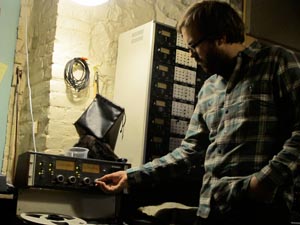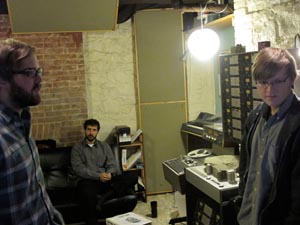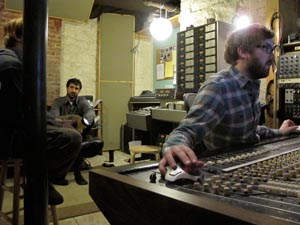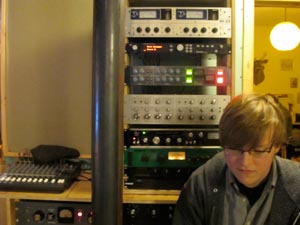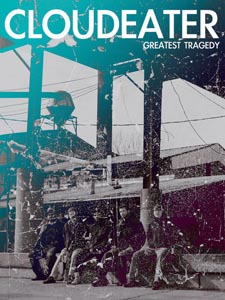Cloudeater Go Genre-Jumping at The Bunker
WILLIAMSBURG, BROOKLYN: John Davis and Aaron Nevezie have been building up the fortifications at their Brooklyn-based Bunker Studio for the better part of a decade. What started as a project studio in a shared live/work space has since evolved into one of the busiest (and most down-to-earth) studios in Brooklyn.
These long-time Radar and tape advocates still keep their Studer in good working order, and have recently added a Pro Tools HD system that features 32 channels of Lynx conversion, along with a rack of a half-dozen of Brent Averill’s 1084s.
Although John and Aaron are steeped in jazz and indie rock backgrounds, The Bunker has long been a hotspot for artists from across genres. Most recently, they’ve hosted Danger Mouse, the Black Keys, and during our visit, Cloudeater, a genre-jumping crew from Atlanta, GA who have inspired interest from rap mogul T.I.’s Grand Hustle label.
At first glance it seems like a surprising connection for a down-tempo band whose singer can shift gears from soulful Stevie Wonder to gut-wrenching indie crooner within a song. But searching for new sounds outside the genre is a growing trend at hip-hop labels that have seen a loss of interest in urban rap artists who have grown predictable and often show trouble attracting a concert-going audience.
To the excitement of execs, hip-hop audiences perked up at the cross-genre release from Blakroc, a project recorded mostly here in Brooklyn, which paired the blues-rock duo Black Keys with Roc-A-Fella artists like Mos Def, RZA, Raekwon and Q-Tip. Although there’s no official agreement between Cloudeater and Grand Hustle, it’s easy to see how the band’s style could pair well with collaborators from the hip-hop world. The boys of Cloudeater are studio-savvy arrangers who know real instruments but can think like programmers.
We got to listen in on a session and talk to the Bunker’s John Davis about mixing a record that’s just as likely to feature a heavy dubstep loop as an all-live piano take.
—
This record cuts across state borders as well as genres. I hear that it was recorded in basement studios as well as commercial facilities. Were there any challenges in bringing it all together?
JD: Even though they were in Atlanta, I was able to get to know what was going on in advance. [Drummer] Chris [Hunt] was sending me rough mixes three months ago. So even though I wasn’t involved in the recording, there was some good pre-production conversation happening.
I think that’s important: I knew what I was getting. It was nice to have an ongoing conversation as opposed to someone coming in and saying “Hey, good morning! Here’s the drive”. (Laughs) “How many tracks are on that song?” “ Oh, I don’t know, just throw away the ones you think sound bad”. It was nice to not have to deal with that.
That sounds great from a logistical standpoint. Does being familiar with the songs in advance help the mix, or do you like surprises?
Oh, I like knowing the songs in advance because then I already know what strikes me as the hook. I know what’s going to get stuck in my head, where I’m going to feel like “that’s f*ing awesome and I really wanna go for this.” It’s easier to decide what sound you want to turn into the focus of a section.
A lot of the important gestures are present in the rough mixes, so it’s often a matter of just expanding on what’s already there. For instance, there’s one song that Chris and I talked about a lot: It’s a song where there’s a huge amount of contrast in the drum track. It goes from super blown-out destroyed-sounding drum mics, to really tight, dry and punchy sounds. When we know those are the sounds in advance, and how they work together, we can decide we want to go even further with that.
It’s much better than pushing the faders up and thinking “oh, where’s the…. what’s the point of this song?” With this style of production it’s even truer than with a folk or roots rock record. Something that’s straight-ahead you can kinda get the idea of immediately. But this isn’t as naturalistic. It would be a little overwhelming to not have an idea.
I gather the band has been taking a single drive from one studio to another, and making rough mixes along the way. How do you treat any automation that may be in there, or any plugins that may have been using for the roughs you heard?
JD: Oh, fortunately there’s none of that! Everything that was good got printed, and everything that was a placeholder was delivered dry. We just got 40-something WAV files to drop into a fresh session with no automation, no assignments. I always throw that sh*t away first, no matter what cause…
You get to focus on the important work first…
JD: Yeah, exactly. Instead of trying to figure out why one of the tracks looks like this (John uses his finger to draw out mountainous squiggles in the air to signify volume automation) just because the person didn’t own a compressor (Laughs)
I know this record was tracked in both commercial studios and residential spaces. What is it like bringing those sounds together? Were there any surprising sources?
JD: There are some things that I thought were done in an interesting way. My favorite drum sound so far is on a song that was recorded in Chris’ basement: They had a stereo PZM mic on the floor and dynamic mic on the hi-hat. It was like the most guerilla recording… but really cool, weird choices. There was still enough quality in the parts that matter, like a Beyer m201 on the snare drum, so it sounds like a snare drum, but they also gave cool, unusual options.
What are some the elements in the mix that are most central to creating the Cloudeater vibe? Are there sounds that you feel a responsibility to bring out the most?
JD: I like the elements that aren’t the most obvious choice, like this guitar loop (John solos a grainy, hypnotic, half-step guitar loop). You don’t necessarily “hear” it in track, but as soon as it’s gone, something’s missing. There’s a bit of the hip-hop element in it. Some of the samples that are looped aren’t quite… “correct”. They’re not quantized, so it gives them a sound that’s a little outside of normal.
The track we’re listening to now has a heavily-gated, distorted mic on the kick drum’s beater head, and that’s most of the drum sound on this song. So for me, it’s about trying to find those elements. Because of the treatment, this performance sounds kind of like a sample even though it’s live. They also printed a normal track with a nice clean snare drum. It’s there if you want it, but that’s not really what this song’s about. It’s kind of my responsibility to help take it all the way in that direction.
That definitely comes across in the relaxed and breathing feel of the track. The sounds have all of the positive qualities of the way loops operate in a track, but without the clichéd pitch-perfect renditions.
Yeah. That’s because it’s not just being made with sample CDs and refill packs. They also have a big network of people to draw, so if there’s percussion, it’s going to be a really great world-music percussionist; It’s not going to be an “Africa refill library” or “GarageBand tribal preset #37” or whatever. So it’s fun because it sounds different. There are some great players, and you can feel that it’s not a loop, I think.
So they think like programmers, but use live instruments to get there.
JD: Yeah. They’re people who know what electronic music sounds like, but also know what instruments sound like. It’s not compartmentalized like: “now we’re playing an instrument so it needs to be clean” or “now we’re programming so the cuffs are off”. I like that: trying to blur the lines between what’s live and what’s not live, and have it not really matter. Just have it sound cool.
Sounds like a very honest communication between genres.
Nolan Kramer: It wouldn’t be possible at all if we didn’t live in the times that we do. We can send each other a stem and say “hear this idea,” or try a different sound and go back and forth before we ever go in the studio. We can try 60 different things and have a pretty solid idea, if not the exact definition of the vibe of what were going for.
Chris Hunt: Yeah. And sometimes it’s great to free yourself from thinking about recording too much. That might sound vague, but I think it’s important: To try to learn from each song, and not get painted into a corner by a preconceived notion about correct technique. It’s OK to try a bunch of things. It’s OK to use a weird mic that’s pointed in a weird place, without guessing that won’t work before you hear it. If we want to put a crash cymbal on top of the snare, drum, hit it like that, and then layer it in with a sample, you know…who cares? It’s allowed.
–
Cloudeater say they’re starting to define their sound with this release. “The same influences are still there, but we’re getting better at camouflaging them” laughs Chris Hunt, “we’re inspired by albums we hear, but it’s getting harder to say ‘oh that’s an R&B bassline’, or ‘that’s kind of a Radiohead sound’. It’s really starting to combine into a more singular feel.”
Whether or not Cloudeater grab the attention of listeners-at-large remains to be seen. At the very least they’re incredibly solid, studio-savvy musicians whose sound is emblematic of a new style of eclectic record-makers who are happy to take inspiration for a compelling line or interesting texture, wherever it may come from. As they say in their own words:
“If Marvin Gaye and Nina Simone had a love child that ran away to play spoons without a spoon for Can, and experimented w/ shrooms with Jimi Hendrix and rode the midnight train all the way home and was writing lyrics on the way, and was greeted by Danger Mouse at the station and they went directly into the studio to start recording but halfway through Trent Reznor kicked everybody out and completed it himself asking only David Bowie’s opinion… Then Cloudeater sounds like the childhood friend of that child.”
After mixing sessions at The Bunker, Scott Hull mastered the Cloudeater album at Masterdisk. For more on Cloudeater, visit http://www.myspace.com/cloudeatermusic, and check out The Bunker at http://www.thebunkerstudio.com.
Justin Colletti is a Brooklyn-based audio engineer and music producer who’s worked with Hotels, DeLeon, Soundpool, Team Genius and Monocle, as well as clients such as Nintendo, JDub, Blue Note Records, and the Metropolitan Museum of Art. Visit him at http://www.justincolletti.com.
Please note: When you buy products through links on this page, we may earn an affiliate commission.








